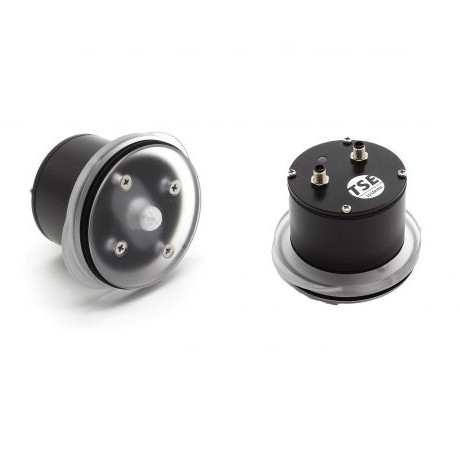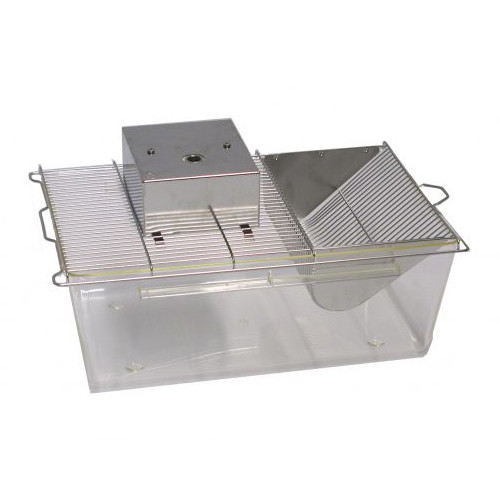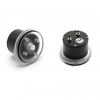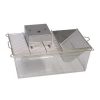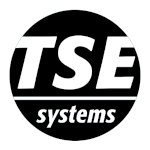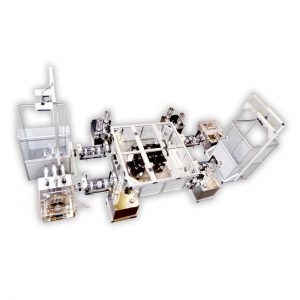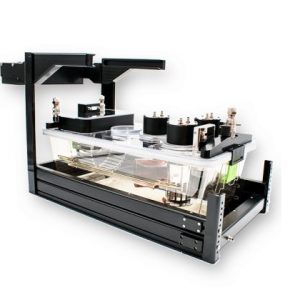InfraMot
Infrared Motion Sensor
Product Enquiry
If you would like to send us an enquiry about this product, please click the button below, fill in the form and submit.
Product EnquiryInfraMot
Infrared Motion Sensor
The TSE InfraMot system is designed to register the total activity of one or more small laboratory animals under any lighting conditions by reliably sensing the movement of heat radiated from the animal bodies. The sensor does not differentiate between horizontal or vertical movement, any activity in the cage is summarized to a gross activity counter instead, making the system especially suited for long-term monitoring of circadian activity.
As part of the PhenoMaster NG research platform, the miniaturized and light-weight sensor unit is mounted on top of a PhenoMaster homecage lid. It can be combined and synchronized with any other measurement module of the PhenoMaster family for a comprehensive evaluation of metabolism, physiology and behavior.
InfraMot is also available as a stand-alone system that can be coupled to standard homecage lids for continuous measurement of gross activity in up to 512 measuring places for high-throughput setups. In this version, it can also be configured for any other arena such as an operant cage.
Measured data can be output in an Actogram, basic statistics are available as tables or in graphical form and export files are easily generated for import into statistics programs for further evaluation.
Features
- Long-term activity measurement under stress-free conditions
- Ideally suited for circadian studies
- Can be operated under any light conditions
- Parallel measurement in a large number of cages
- Miniature sensor unit for PhenoMaster cage lids
- Multi-purpose sensor units for standard cages
Application
- Circadian Rhythm
- Spontaneous Activity
Module of
Selected Publications
Mett A, Karbat I, Tsoory M, Fine S, Iwanir S, Reuveny E. Reduced activity of GIRK1-containing heterotetramers is sufficient to affect neuronal functions, including synaptic plasticity and spatial learning and memory. J Physiol 2020 Oct 30. Epub ahead of print
Pewzner-Jung Y, Joseph T, Blumenreich S, Vardi A, Ferreira NS, Cho SM, Eilam R, Tsoory M, Biton IE, Brumfeld V, Haffner-Krausz R, Brenner O, Sharabi N, Addadi Y, Salame TM, Rotkopf R, Wigoda N, Yayon N, Merrill AH, Schiffmann R, Futerman AH. Brain pathology and cerebellar purkinje cell loss in a mouse model of chronic neuronopathic Gaucher disease. Prog Neurobiol 2020 Nov 2:101939. Epub ahead of print.
Shemer A, Scheyltjens I, Frumer GR, Kim JS, Grozovski J, Ayanaw S, Dassa B, Van Hove H, Chappell-Maor L, Boura-Halfon S, Leshkowitz D, Mueller W, Maggio N, Movahedi K, Jung S. Interleukin-10 Prevents Pathological Microglia Hyperactivation following Peripheral Endotoxin Challenge. Immunity 2020 Oct 12: S1074-7613(20)30412-X. Epub ahead of print.
Sokolowska E, Viitanen R, Misiewicz Z, Mennesson M, Saarnio S, Kulesskaya N, Kängsep S, Liljenbäck H, Marjamäki P, Autio A, Callan SA, Nuutila P, Roivainen A, Partonen T, Hovatta I. The circadian gene Cryptochrome 2 influences stress-induced brain activity and depressive-like behavior in mice. Genes Brain Behav 2020 Oct 17:e12708.
Selected Product Citations
DYNLRB1 is essential for dynein mediated transport and neuronal survival |
|
| Marco Terenzio, Agostina Di Pizio, Pierluigi Di Matteo | Neurobiol Dis | Published 1 Jul 2020 |
| Article Snippet Home-cage locomotion test Wild type and RNX3-Dynlrb1 -/- mice were monitored over 72 h using the InfraMot system (TSE Systems, Germany) in order to investigate possible alterations of basal motor activity and/or circadian rhythms.. Statistical analysis was carried out with a one-way ANOVA followed by Tukey post-hoc multiple comparison test using the statistical software GraphPad Prism. |
|
Passive immunotherapy for N-truncated tau ameliorates the cognitive deficits in two mouse Alzheimer’s disease models |
|
| Veronica Corsetti, Antonella Borreca, …, Giuseppina Amadoro | Brain Commun | Published 6 Apr 2020 |
| Article Snippet Locomotor activity was assessed during the indirect calorimetric assay by the number of infra-red beams broken.. Each cage of the calorimeter system is equipped with the InfraMot® device that uses ‘passive infrared sensors’ to detect and record the motor activity of the mouse by the body-heat image and its spatial displacement across time.. Any type of body movement was detected and recorded as activity counts. InfraMot , 302015 , 302015 , inframot , InfraMot® device , |
|
Stimulation of P2X7 Enhances Whole Body Energy Metabolism in Mice |
|
| Giacomo Giacovazzo, Paola Fabbrizio, …, Cinzia Volonté | Front Cell Neurosci | Published 21 Aug 2019 |
| Article Snippet Locomotor activity was assessed during the indirect calorimetric assay by the number of infrared beams broken.. Each cage of the calorimeter system is equipped with the InfraMot® device that uses “passive infrared sensors” to detect and record the motor activity of the mouse by the body-heat image and its spatial displacement across time.. EE was also analyzed by considering animals’ steady conditions or lack of motor activity (only values included between 0 and 3 activity counts were included) and indicated as resting EE (REE). |
|

